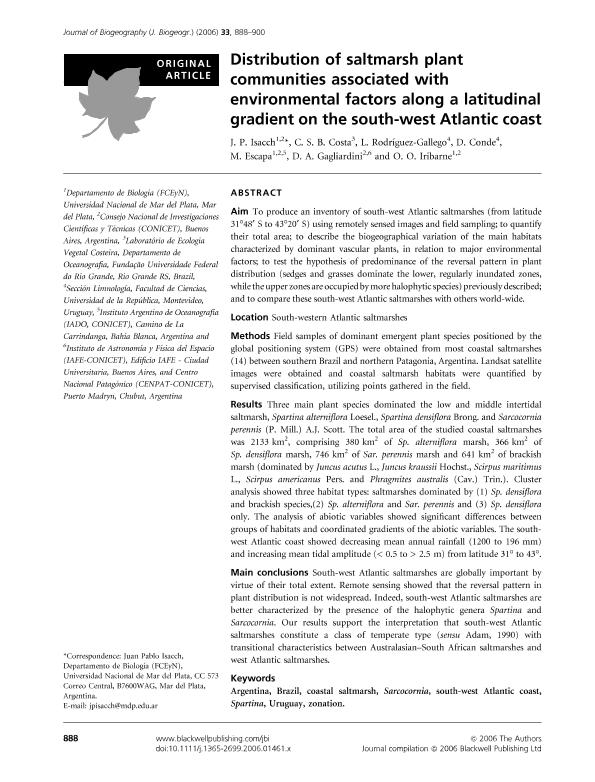Artículo
Distribution of saltmarsh plant communities associated with environmental factors along a latitudinal gradient on the south-west Atlantic coast
Isacch, Juan Pablo ; Costa, C. S. B.; Rodríguez Gallego, L.; Conde, D.; Escapa, Mauricio; Gagliardini, Domingo Antonio
; Costa, C. S. B.; Rodríguez Gallego, L.; Conde, D.; Escapa, Mauricio; Gagliardini, Domingo Antonio ; Iribarne, Oscar Osvaldo
; Iribarne, Oscar Osvaldo
 ; Costa, C. S. B.; Rodríguez Gallego, L.; Conde, D.; Escapa, Mauricio; Gagliardini, Domingo Antonio
; Costa, C. S. B.; Rodríguez Gallego, L.; Conde, D.; Escapa, Mauricio; Gagliardini, Domingo Antonio ; Iribarne, Oscar Osvaldo
; Iribarne, Oscar Osvaldo
Fecha de publicación:
12/2006
Editorial:
Wiley Blackwell Publishing, Inc
Revista:
Journal of Biogeography
ISSN:
0305-0270
Idioma:
Inglés
Tipo de recurso:
Artículo publicado
Clasificación temática:
Resumen
Aim To produce an inventory of south-west Atlantic saltmarshes (from latitude 31 48 ¢ Sto43 20 ¢ S) using remotely sensed images and field sampling; to quantify their total area; to describe the biogeographical variation of the main habitats characterized by dominant vascular plants, in relation to major environmental factors; to test the hypothesis of predominance of the reversal pattern in plant distribution (sedges and grasses dominate the lower, regularly inundated zones, whiletheupper zones are occupiedby more halophytic species)previously described; and to compare these south-west Atlantic saltmarshes with others world-wide. Location South-western Atlantic saltmarshes Methods Field samples of dominant emergent plant species positioned by the global positioning system (GPS) were obtained from most coastal saltmarshes (14) between southern Brazil and northern Patagonia, Argentina. Landsat satellite images were obtained and coastal saltmarsh habitats were quantified by supervised classification, utilizing points gathered in the field. Results Three main plant species dominated the low and middle intertidal saltmarsh, Spartina alterniflora Loesel., Spartina densiflora Brong. and Sarcocornia perennis (P. Mill.) A.J. Scott. The total area of the studied coastal saltmarshes was 2133 km 2 , comprising 380 km 2 of Sp. alterniflora marsh, 366 km 2 of Sp. densiflora marsh, 746 km 2 of Sar. perennis marsh and 641 km 2 of brackish marsh (dominated by Juncus acutus L., Juncus kraussii Hochst., Scirpus maritimus L., Scirpus americanus Pers. and Phragmites australis (Cav.) Trin.). Cluster analysis showed three habitat types: saltmarshes dominated by (1) Sp. densiflora and brackish species,(2) Sp. alterniflora and Sar. perennis and (3) Sp. densiflora only. The analysis of abiotic variables showed significant differences between groups of habitats and coordinated gradients of the abiotic variables. The south- west Atlantic coast showed decreasing mean annual rainfall (1200 to 196 mm) and increasing mean tidal amplitude (< 0.5 to > 2.5 m) from latitude 31 to 43 . Main conclusions South-west Atlantic saltmarshes are globally important by virtue of their total extent. Remote sensing showed that the reversal pattern in plant distribution is not widespread. Indeed, south-west Atlantic saltmarshes are better characterized by the presence of the halophytic genera Spartina and Sarcocornia . Our results support the interpretation that south-west Atlantic saltmarshes constitute a class of temperate type ( sensu Adam, 1990) with transitional characteristics between Australasian–South African saltmarshes and west Atlantic saltmarshes.
Archivos asociados
Licencia
Identificadores
Colecciones
Articulos(IADO)
Articulos de INST.ARG.DE OCEANOGRAFIA (I)
Articulos de INST.ARG.DE OCEANOGRAFIA (I)
Articulos(IIMYC)
Articulos de INSTITUTO DE INVESTIGACIONES MARINAS Y COSTERAS
Articulos de INSTITUTO DE INVESTIGACIONES MARINAS Y COSTERAS
Citación
Isacch, Juan Pablo; Costa, C. S. B.; Rodríguez Gallego, L.; Conde, D.; Escapa, Mauricio; et al.; Distribution of saltmarsh plant communities associated with environmental factors along a latitudinal gradient on the south-west Atlantic coast; Wiley Blackwell Publishing, Inc; Journal of Biogeography; 33; 5; 12-2006; 888-900
Compartir
Altmétricas



